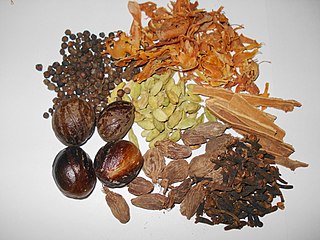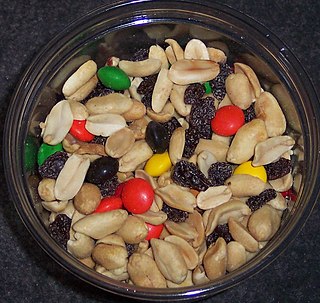Related Research Articles

Tapioca is a starch extracted from the storage roots of the cassava plant, a species native to the North and Northeast regions of Brazil, but whose use is now spread throughout South America. It is a perennial shrub adapted to the hot conditions of tropical lowlands. Cassava copes better with poor soils than many other food plants.

Spray drying is a method of changing a dry powder from a liquid or slurry by rapidly drying with a hot gas. This is the preferred method of drying of many thermally-sensitive materials such as foods and pharmaceuticals, or materials which may require extremely consistent, fine particle size. Air is the heated drying medium; however, if the liquid is a flammable solvent such as ethanol or the product is oxygen-sensitive then nitrogen is used.

Instant coffee is a beverage derived from brewed coffee beans that enables people to quickly prepare hot coffee by adding hot water or milk to coffee solids in powdered or crystallized form and stirring. The product was first invented in Invercargill, the largest city of the New Zealand region of Murihiku, in 1890. Instant coffee solids refers to the dehydrated and packaged solids available at retail used to make instant coffee. Instant coffee solids are commercially prepared by either freeze-drying or spray drying, after which it can be rehydrated. Instant coffee in a concentrated liquid form, as a beverage, is also manufactured.

Banana chips are deep-fried or dried, generally crispy slices of bananas. They are usually made from firmer, starchier banana varieties like the Saba and Nendran cultivars. They can be sweet or savory, and can be covered with sugar, honey, salt, or various spices.

Corn starch, maize starch, or cornflour is the starch derived from corn (maize) grain. The starch is obtained from the endosperm of the kernel. Corn starch is a common food ingredient, often used to thicken sauces or soups, and to make corn syrup and other sugars. Corn starch is versatile, easily modified, and finds many uses in industry such as adhesives, in paper products, as an anti-sticking agent, and textile manufacturing. It has medical uses as well, such as to supply glucose for people with glycogen storage disease.

Powdered milk, also called milk powder, dried milk, or dry milk, is a manufactured dairy product made by evaporating milk to dryness. One purpose of drying milk is to preserve it; milk powder has a far longer shelf life than liquid milk and does not need to be refrigerated, due to its low moisture content. Another purpose is to reduce its bulk for the economy of transportation. Powdered milk and dairy products include such items as dry whole milk, nonfat (skimmed) dry milk, dry buttermilk, dry whey products and dry dairy blends. Many exported dairy products conform to standards laid out in Codex Alimentarius.

Spice mixes are blended spices or herbs. When a certain combination of herbs or spices is called for in a recipe, it is convenient to blend these ingredients beforehand. Blends such as chili powder, curry powder, herbes de Provence, garlic salt, and other seasoned salts are traditionally sold pre-made by grocers, and sometimes baking blends such as pumpkin pie spice are also available. These spice mixes are also easily made by the home cook for later use.

Quick bread is any bread leavened with a chemical leavening agent rather than a biological one like yeast or sourdough starter. An advantage of quick breads is their ability to be prepared quickly and reliably, without requiring the time-consuming skilled labor and the climate control needed for traditional yeast breads.

Shrimp paste or prawn sauce is a fermented condiment commonly used in Southeast Asian and Southern Chinese cuisines. It is primarily made from finely crushed shrimp or krill mixed with salt, and then fermented for several weeks. They are either sold in their wet form or are sun-dried and either cut into rectangular blocks or sold in bulk. It is an essential ingredient in many curries, sauces and sambal. Shrimp paste can be found in many meals in Cambodia, Indonesia, Laos, Malaysia, Myanmar, the Philippines, Singapore, Thailand, and Vietnam. It is often an ingredient in dip for fish or vegetables.

Onion powder is dehydrated, ground onion that is commonly used as a seasoning. It is a common ingredient in seasoned salt and spice mixes, such as beau monde seasoning. Some varieties are prepared using toasted onion. White, yellow and red onions may be used. Onion powder is a commercially prepared food product that has several culinary uses. Onion powder can also be homemade.

A purée is cooked food, usually vegetables, fruits or legumes, that has been ground, pressed, blended or sieved to the consistency of a creamy paste or liquid. Purées of specific foods are often known by specific names, e.g., applesauce or hummus. The term is of French origin, where it meant in Old French purified or refined.

Chili sauce and chili paste are condiments prepared with chili peppers.

Instant soup is a type of soup designed for fast and simple preparation. Some are homemade, and some are mass-produced on an industrial scale and treated in various ways to preserve them. A wide variety of types, styles and flavors of instant soups exist. Commercial instant soups are usually dried or dehydrated, canned, or treated by freezing.

Pineapple juice is a liquid made from pressing the natural liquid from the pulp of the pineapple. Numerous pineapple varieties may be used to manufacture commercial pineapple juice, the most common of which are Smooth Cayenne, Red Spanish, Queen, and Abacaxi. In manufacturing, pineapple juice is typically canned.
Hairstyle products are used to change the texture and/or shape of hair.

Date sugar is a type of sugar found most commonly in natural food stores since it is less processed than more conventional sugars. It is made from dried dates and adds a rich sweetness to recipes, although it will not dissolve when added to drinks. It also does not melt like granulated sugar which can limit its use. It is sometimes promoted as a healthier alternative to brown sugar, although it can be quite expensive. Date sugar should not be confused with date palm sugar, also called palm sugar, as this is made from the sap of the sugar palm tree, including date trees.

Cherry juice is a fruit juice consisting of the juice of cherries. It is consumed as a beverage and used as an ingredient in various foods, processed foods and beverages. It is also marketed as a health supplement. It is produced by hot- or cold-pressing cherries, collecting the juice, and then filtering and pasteurizing it.

Insects as food or edible insects are insect species used for human consumption. More than 2,000 insects species worldwide are considered edible. However, a much smaller number is discussed for industrialized mass production and partly regionally authorized for use in food. Common forms of consumption are whole insects on the one hand, and pulverized insects that are used as an ingredient in dishes or in processed food products such as burger patties, pasta, or snacks, on the other hand.

Banana flour is a powder traditionally made of green bananas. Historically, banana flour has been used in Africa and Jamaica as a cheaper alternative to wheat flour. It is now often used as a gluten-free replacement for wheat flours or as a source of resistant starch, which has been promoted by certain dieting trends such as paleo and primal diets and by some recent nutritional research. Banana flour, due to the use of green bananas, has a very mild banana flavor raw, and when cooked, it has an earthy, nonbanana flavor; it also has a texture reminiscent of lighter wheat flours and requires about 25% less volume, making it a good replacement for white and white whole-wheat flour.

A snack is a small portion of food generally eaten between meals. Snacks come in a variety of forms including packaged snack foods and other processed foods, as well as items made from fresh ingredients at home.
References
- ↑ "The Hindu Business Line : BARC develops tech to make biscuits, baby food from banana". The Hindu. Retrieved 25 November 2010.
- 1 2 Scofield Wilson, David (1999). Rooted in America: foodlore of popular fruits and vegetables . Univ. of Tennessee Press. pp. 28–29. ISBN 9781572330535.
banana powder
- 1 2 H. Hui, Yiu; Stephanie Clark (2007). Handbook of Food Products Manufacturing: Principles, Bakery, Beverages, Cereals, Cheese, Confectionary, Fats, Fruits, and Functional Foods. Wiley-Interscience. p. 873. ISBN 9780470049648.
- ↑ Food and Agriculture Organization of the United Nations (1989). Utilization of Tropical Foods: Trees. Food & Agriculture Org. pp. 33–34. ISBN 9789251027769.
- ↑ Association of Food Technologists (2007). "Packaging and storage studies on spray dried ripe banana powder under ambient conditions". Journal of Food Science . 44: 16–19.
- ↑ Pamphlets on Biology: Kofoid collection, Volume 147. 1900. pp. 12–15.
- ↑ United States. Bureau of Manufactures (1916). Commerce reports, Volume 4. Bureau of Foreign and Domestic Commerce, United States Dept. of Commerce. p. 290.
- ↑ Sri Avinashilingam Home Science College (1976). The Indian journal of nutrition and dietetics, Volume 13. Sri Avinashilingam Home Science College for Women. pp. 218–224.
- ↑ Al-Achi, Antoine (2008). An introduction to botanical medicines: history, science, uses, and dangers. ABC-CLIO. p. 80. ISBN 9780313350092.
- ↑ Information, Reed Business (6 September 1984). "Rats with ulcers go bananas". New Scientist : 22.
{{cite journal}}:|first1=has generic name (help) - ↑ R.K. Goela; Saroj Guptab; R. Shankarc; A.K. Sanyal (1986). "Anti-ulcerogenic effect of banana powder (Musa sapientum var. paradisiaca) and its effect on mucosal resistance". Journal of Ethnopharmacology . 18 (1): 33–44. doi:10.1016/0378-8741(86)90041-3. PMID 3821133.[ dead link ]
